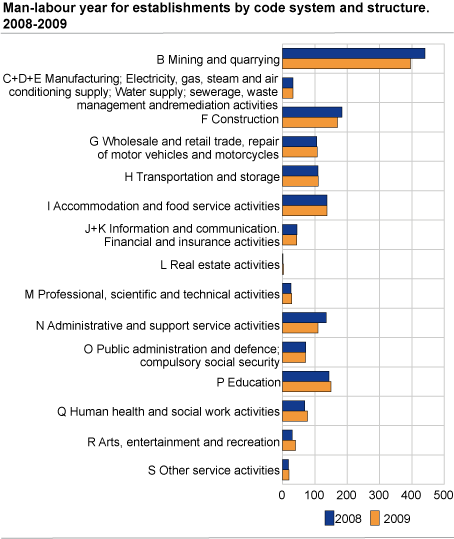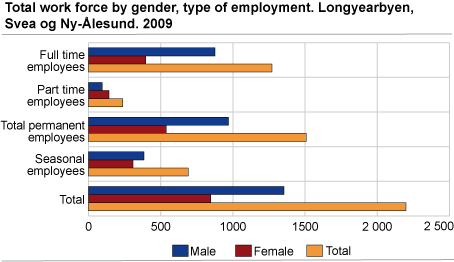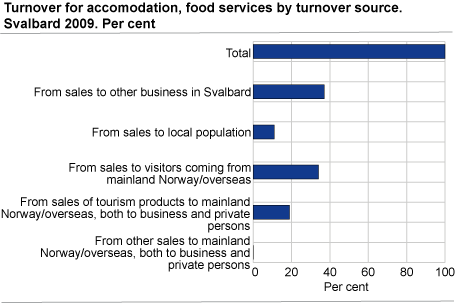Content
Published:
This is an archived release.
Decreasing turnover in Svalbard
Preliminary figures show that turnover for local KAUs operating in Svalbard decreased by more than 27 per cent from 2008 to 2009, or from NOK 5.5 billion to NOK 4 billion.
The highest decrease in turnover was found in mining and quarrying, from about NOK 3.4 billion in 2008 to NOK 2 billion in 2009, i.e. down by 40 per cent. This is due to both a lower coal price and reduced sales quantities in the wave of the financial crisis. The coal price reached a level under USD 60 per tonne many times in 2009, and peaked at USD 79 per tonne at the end of the year. In 2008 the coal price was on average recorded at USD 175 per tonne. According to the annual report for “Store Norske Spitsbergen kullkompani”, the sales quantities decreased by 1 million tonne from 2008 to 2009. The turnover also decreased in most other industries, especially in construction, manufacturing and education.
Some industries experienced an increase in turnover from 2008 to 2009. Transportation and storage had a turnover of NOK 229 million in 2009; an increase of over NOK 17 million compared with 2008. Turnover in Arts, entertainment and recreation increased by NOK 13.5 million.
Growth in the number of local KAUs in 2009
The number of local KAUs in Svalbard increased from 172 in 2008 to 190 in 2009. Most of the new unities established operate within Arts, entertainment and recreation. The 26 local KAUs operating within the wholesale and retail trade, repair of motor vehicles and motorcycles accounted for 14 per cent of the total of local KAUs. A total of 22 local KAUs were operating in Administrative and support service industry. These represented nearly 12 per cent of the total local KAUs. The corresponding figure for the industry of Real estate activities was 11 per cent.
NOK 388 million in public subsidies
Public subsidies to industries in Svalbard came to NOK 388 million in 2009; a 2.5 per cent increase compared with 2008. Most of the public subsidies were received by public administration, defence and compulsory social security industry and education.
Education with most man-labour years in the public sector
Most establishments were found in Arts, entertainment and recreation in 2009. The 19 local KAUs offering these services had few employees; only 40 man-labour years. Education comprised 150 man-labour years, while Human health and social work activities accounted for 77 man-labour years. Public administration represented 71 man-labour years.
Most man-labour years in Mining and quarrying
The number of man-labour years reached 1 495 for the local KAUs operating in Svalbard in 2009; 52 man-years less than in 2008. A total of 396 man-years were in Mining and quarrying, down 10 per cent -or by 45 - compared with 2008. Accommodation and food service activities’ man-labour years were 9 per cent of the total, while Construction industry comprised 11 per cent. The average wage cost per man-labour year was approximately NOK 686 000, up 3 per cent from 2008.
There were a total of 1 271 full-time employees at Svalbard in 2009, 69 of whom were men. As regards part-time employees, women accounted for 60 per cent. There were 691 seasonal employees at Svalbard in 2009; 28 per cent of the total work force.
Investments
The investments in Svalbard in 2009 amounted to NOK 288 million; NOK16 million less than in 2008. This decrease was mainly due to lower investment activity in Mining and quarrying. Information and communication was the industry with the largest investments.
Reduced turnover for Accommodation and food service activities
The turnover in Accommodation and food service activities decreased from NOK 210 million in 2008 to NOK 200 million in 2009, despite the increase in the number of the local KAUs’ operation in that industry. The proportion of sales to other establishments in Svalbard accounted for 37 per cent of the total turnover coming from Accommodation and food service activities in 2009. As regards sales of tourism products to tourists visiting Svalbard, this proportion was 34 per cent. Sales of tourism products to the continental-Norway/foreigners - both to firms and private persons- represented 19 per cent of the total turnover in Accommodation and food service activities.
|
Business statistics for Svalbard includes the Norwegian settlement in Longyearbyen, Svea and Ny-Ålesund. The Russian settlement is not included. |
|
The industries are classified according to the Standard Industrial Classification (SIC2007), which is based on EU’s industrial standard NACE Rev. 2 and the UN’s industrial standard ISIC Rev.3. |
|
Public subsidies comprise allocations received from the government, the local government in Longyearbyen, Svalbard Samfunnsdrift and other public bodies (e.g. Innovation Norway) for operations and investments. |
|
Statistics Norway is responsible for the data collection for industry statistics for Svalbard from the reference year 2008 onwards. The industry statistics serve as an instrument to monitor the development at Svalbard, both for the government and for the local population. In order to be able to compare the industry statistics for Svalbard with the structural business statistics for mainland Norway, the data collection in Svalbard has been carried out using the same principles as for the structural business statistics for mainland Norway. |
Tables:
Contact
-
Mikael Sandberg
E-mail: mikael.sandberg@ssb.no
tel.: (+47) 40 81 14 99



